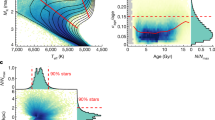Abstract
In order to confirm and refine the results obtained in a previous paper (hereafter referred to as Paper II), the chemical evolution of two-component (spheroid+disk) galaxies is derived rejecting the instantaneous recycling approximation, by means of numerical computations, accouting for (i) the collapse phase of the gas, assumed to be uniform in density and composition, and (ii) a birth-rate stellar function
where μ can be related to the usual density term whilex is a volume term first introduced in Paper II; computations are performed relatively to the solar neighbourhood and to model galaxies which closely resemble the real morphological sequence: in both cases, numerical results are compared with analytical ones. As regards the solar neighbourhood, we find the parametersn andq changed to about the value 10–20% with respect to the analytical one, andZ(t) (i.e., metallicity curve) values lowered to about the value≲25% with respect to the analytical one; moreover, spheroid star birth is intermediate between an initial burst and an uniform generation, while more than 90% with respect to the present-day (gas+star) disk is primary.
As regards other galaxies, we find that when the disk component is dominant (i.e., in late-type spirals or irregulars) the numerical present-day values of the gas mass-fraction μ(T) and of the metallicityZ(T) differ by a few per cent from the corresponding analytical ones, while the main part of present-day disks is primary; on the contrary, when the spheroid component is dominant, μ(T) andZ(T) are ≈50% different from the corresponding analytical ones, while a substantial fraction of present-day disks is secondary: moreover, super-metallic effect takes place, as a direct consequence of rejecting instantaneous recycling. However, the qualitative conclusions of Paper II continue to hold, so we can state that analytical models constitute a zero-th order approximation in describing the chemical evolution of both solar neighbourhood and other galaxies; numerical models of this paper constitute a first-order approximation, while higher order approximations could be made by rejecting the hypothesis of uniform density and composition, and making use of detailed dynamical models.
Similar content being viewed by others
References
Blaauw, A.: 1965, inStars and Stellar Systems (Univ. of Chicago Press), vol. V, p. 435.
Caimmi, R.: 1978a,Astrophys. Space Sci. 54, 453. (Paper I).
Caimmi, R.: 1978b,Astrophys. Space Sci. 59, 109. (Paper II).
Di Fazio, A., Occhionero, F., and Vagnetti, F.: 1978, submitted to:Astron. Astrophys.
Gratton, L.: 1975, in G. Setti (ed.),Structure and Evolution of Galaxies, p. 13.
Larson, R. B.: 1976,Monthly Notices Roy. Astron. Soc. 176, 31.
Ostriker, J. P. and Thuan, T. X.: 1975,Astrophys. J. 202, 353.
Pagel, B. E. J. and Patchett, B. E.: 1975,Monthly Notices Roy. Astron. Soc. 172, 13.
Schmidt, M.: 1963,Astrophys. J. 137, 758.
Talbot, R. J. and Arnett, W. D.: 1971,Astrophys. J. 170, 409.
Tinsley, B. M. and Larson, R. B.: 1978,Astrophys. J. 221, 554.
Author information
Authors and Affiliations
Rights and permissions
About this article
Cite this article
Caimmi, R. Chemical evolution of two-component galaxies. Astrophys Space Sci 59, 413–429 (1978). https://doi.org/10.1007/BF01023928
Received:
Issue Date:
DOI: https://doi.org/10.1007/BF01023928




